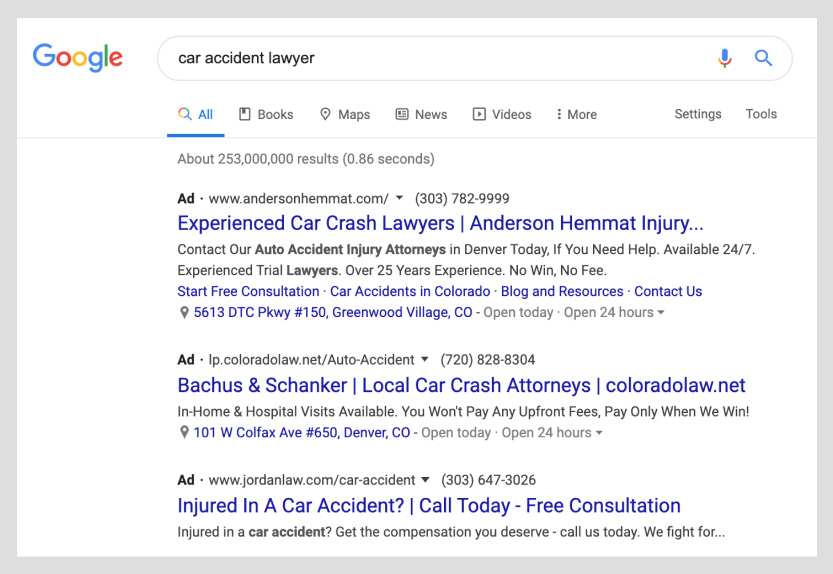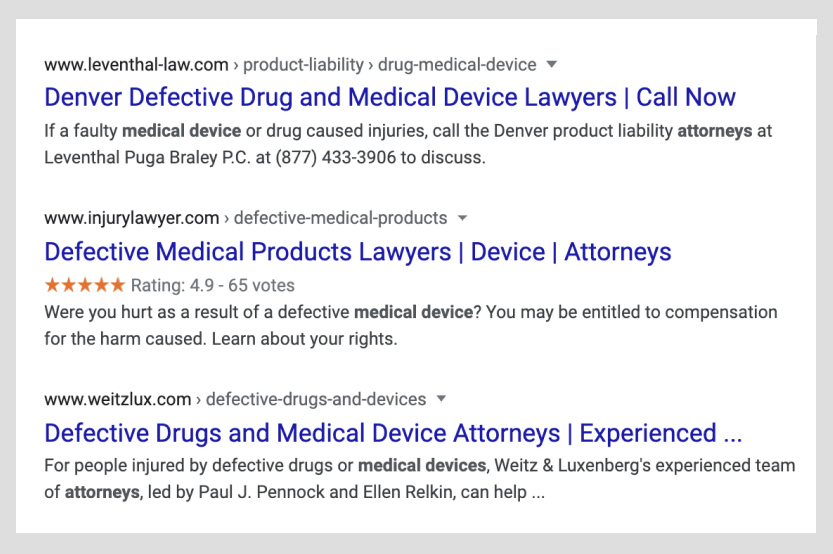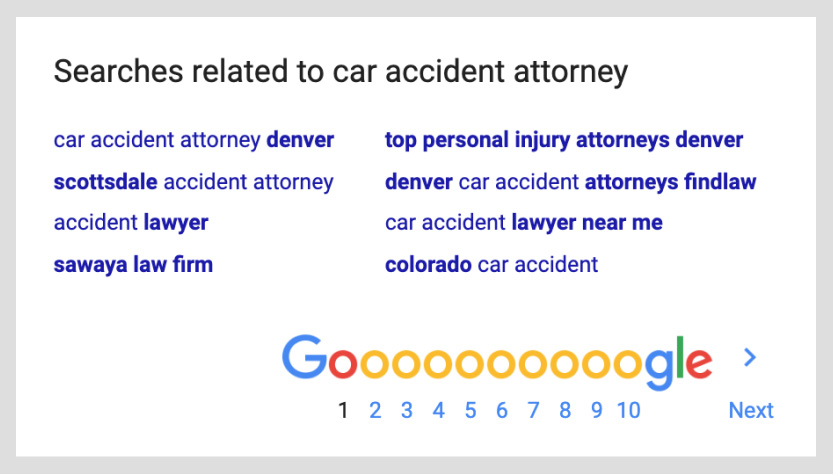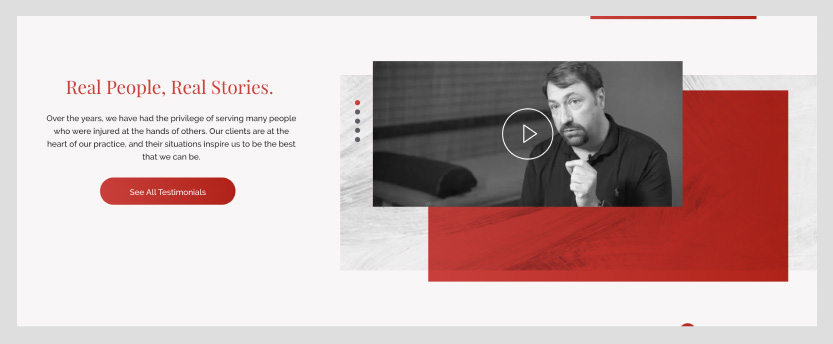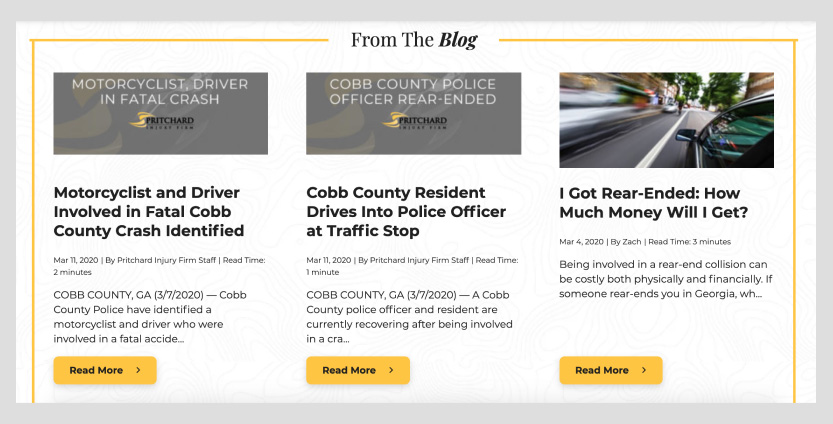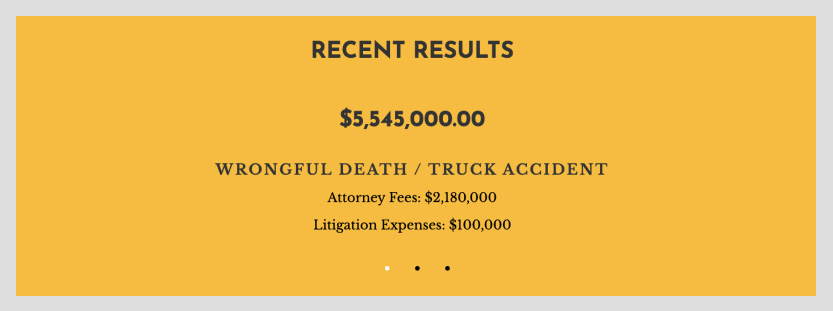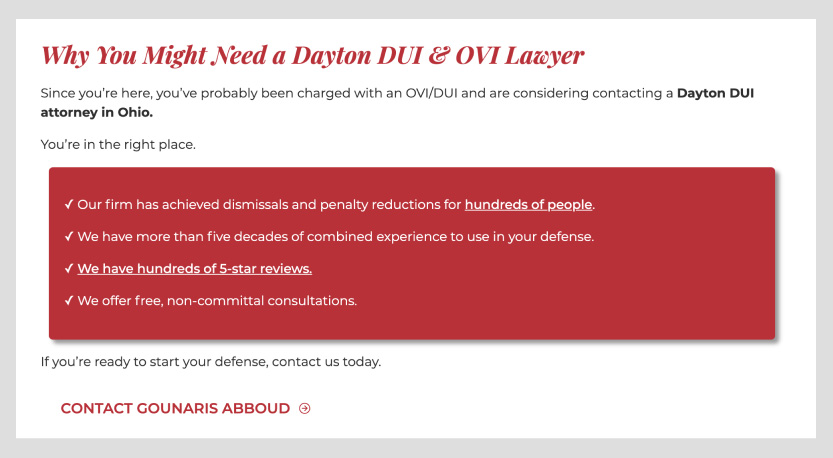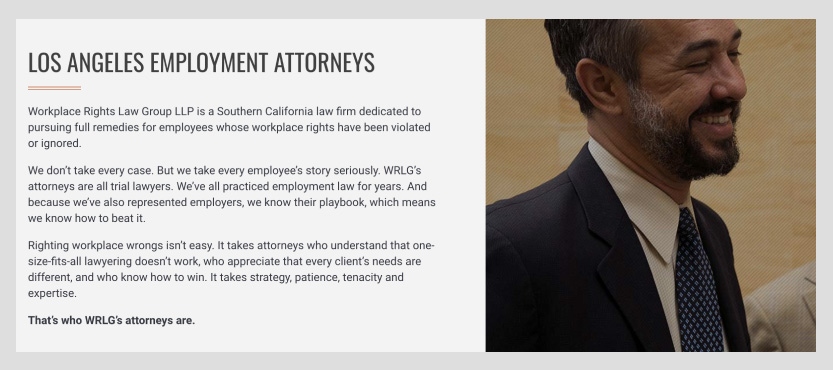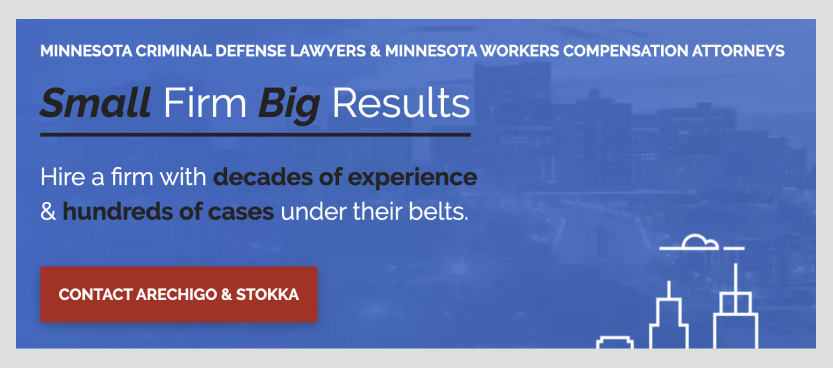Writing high-converting ads is tricky enough, and lawyers have extra considerations when it comes to Google Ads.
In this post, we’re going to show you exactly how to write great Google Ads for lawyers.
We’ll discuss the following:
- How to ensure your ads are bar-compliant
- How to nail your quality scores
- How to write high-converting landing pages
… and more.
Let’s dive right in.
Anatomy of a Google Ad
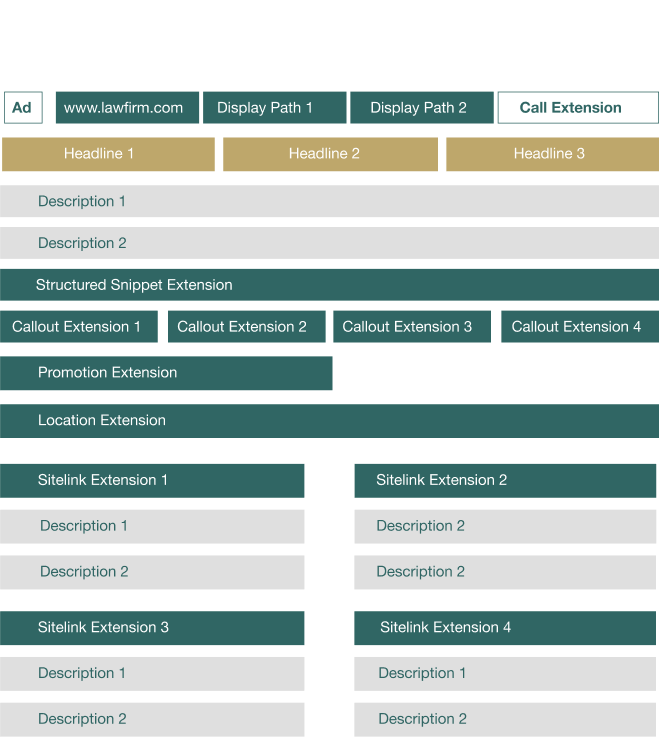
There are a few elements of a Google Ad that you can optimize for rankings and conversions.
- Final URL and display path
- Headlines 1, 2, and 3
- Descriptions 1 and 2
- Sitelink extensions
- Callout extensions
- Call extensions
- Location extensions
- Structured snippet extensions
- Promotion extensions
- Lead form extensions
Make sure to include all these elements in your ads (even though Google won’t always show all of them). You can increase your click-through-rate (CTR) by taking up more “real estate,” or space, on the search engine results page (SERP).
Let’s discuss these in detail.
Final URL & display path
The final URL is a link to the ad’s corresponding landing page.
However, the display path is what actually appears in your ad. So the final URL might be www.lawfirm.com, but the ad shows the display path, such as www.lawfirm.com/practice-area/location.
Your display path should include keywords. You have 15 characters to work with for each of the two subfolders, for example: lawfirm.com/_____/_____.

Headlines 1, 2, and 3
Headlines are perhaps the most important element of your Google ads.
Often, searchers read only the titles. Note that each headline allows up to 30 characters.
When writing titles, try to do the following.
Headline 1 = keyword
Like organic SEO for lawyers, keywords are crucial. Your first title needs to include a target keyword, like “personal injury lawyer LA.”
Headline 2 and 3 = ad copy
Your second title should be catchier and emotional, leveraging either a unique value proposition or empathetic statements targeting potential clients.
In most cases, your headline 3 should be your law firm name.

Descriptions 1 and 2
Your descriptions should include keywords, value propositions, and other selling points. If possible, relate your descriptions directly to the landing page to increase your Quality Score.
We’ll discuss Quality Score later.
To further optimize your descriptions, include a call-to-action, like “schedule a consultation.” Remember that descriptions can be up to 90 characters.
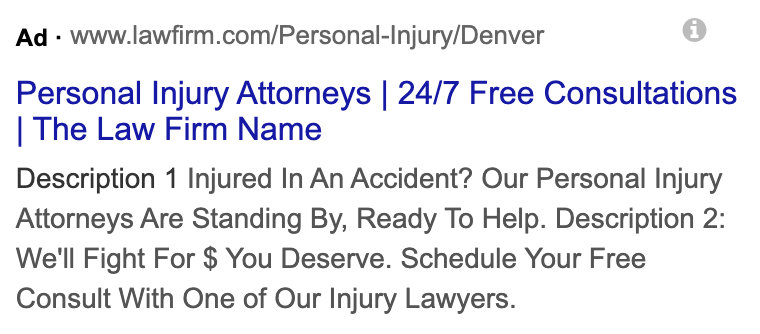
Sitelink extensions
Sitelinks are deep links that take users to specific pages of your site. For example, you could include sitelinks that direct users to contact, case results, about, and practice areas pages. You could also link your sitelink extensions to certain practice areas.
There is a sitelink extensions heading (25 characters) and 2 descriptions (35 characters each).

Callout extensions
Sitelinks and callouts may look the same on the backend, but the key difference is that sitelinks contain a link while callouts are just text. As you might expect, sitelinks appear in blue, indicating a clickable link. Callouts look like regular gray ad text and are 25 characters long.
Callout links draw potential clients’ attention to what you have to offer, such as special promotions or value propositions. Since they allow you to add more text to your ads, callouts can increase your click-through-rate.

Location extensions
Location extensions are a must. Not only do they provide potential clients quick access to your contact information, they help completely fill out your ads (which Google does take into consideration when ranking ads).
Location extensions are also the only way that your call ads can appear in the “map pack,” or the top three local search results on the search engine results page. Since Google prioritizes a searcher’s location, appearing in the local results can get you a lot of leads.
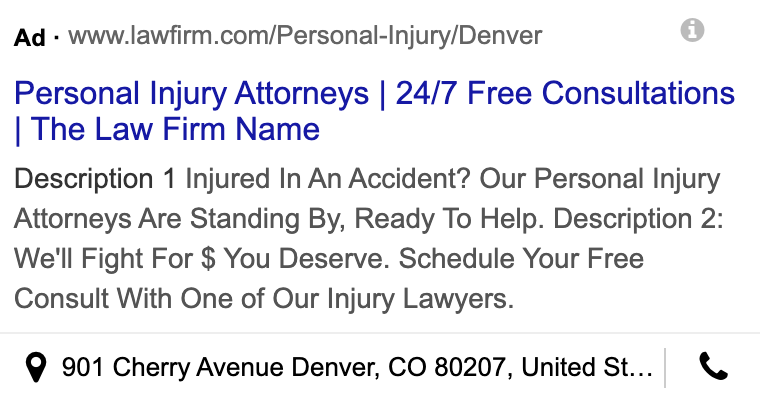
Call extensions
These are simple. Add your phone number so users can call your firm right on the search engine results page.
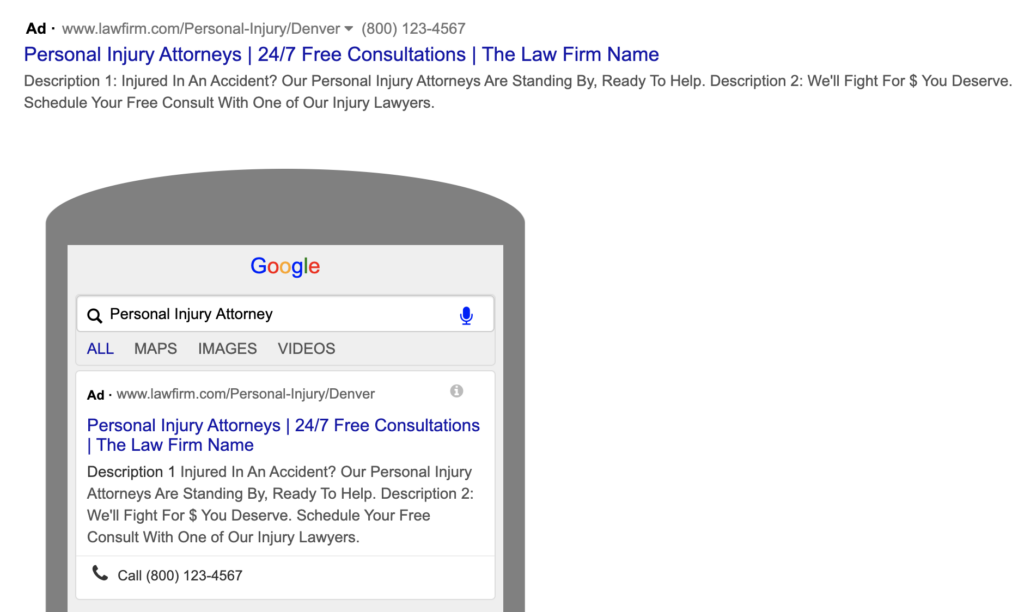
Structured snippet extensions
Structured snippet extensions are essentially larger callout sections with a brief headline and description. They are an opportunity to mention and explain unique attributes of your firm, like how many clients you’ve served and how long you’ve been in business.
There can be a few, but they are only 25 characters each.
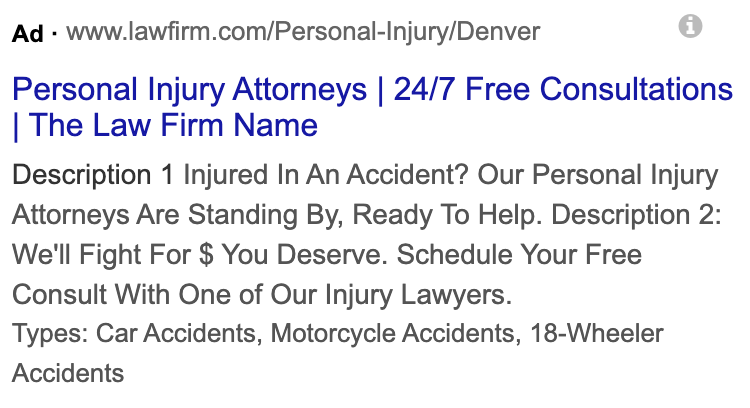
Promotion extensions
Promotion extensions are 20-character snippets of text that announce a special or promotion. For example, “100% free consultations.”
Lead form extensions
At the time of this writing, lead form extensions are a new feature and still being tested. That being said, they are a huge opportunity for capturing leads right on the search engine results page. Additionally, you can integrate these leads directly into your firm’s CRM for tracking.
How to find keywords for your Google Ads
If you don’t strategically identify target keywords to rank for, your Google Ads are far less likely to reach potential clients.
There are a few ways to create a keyword list.
Use tools
There are a few tools that you can use to identify keywords for your Google Ads for lawyers.
For Google Ads, the simplest and most affordable tool is Google’s Keyword Planner. If you have an ad campaign, the tool is free.
To start, enter a keyword you would like to rank for in the search bar. The Keyword Planner will suggest lots of keywords (sometimes thousands) to add to your list, along with data about average cost-per-click (CPC) and search volume per month.
If you have room in your marketing budget for paid tools, we highly recommend Ahrefs.com, Spyfu.com, or SEMRush.com. Relying on Google Keyword Planner alone isn’t highly advised; it’s always best to cross-reference data across tools to get a more accurate picture.
Use the search engine results page
If you’re not interested in paying for tools or are looking for more information outside of Google Keyword Planner, the SERP is a great place to start.
When you enter a search term, there are a few features on the SERP that provide keyword ideas to use when you start out.
First, you can analyze your competitors’ ads.
For example, the top-ranking ad uses “injury lawyers” for car accident search terms.
However, be aware that many ad agencies use keyword insertion, one of Google Ads’ dynamic ad features. Advertisers that use keyword insertion allow their ads’ target keywords to be automatically filled using the searcher’s search phrase. So, when you’re doing research, the ads you see may be automatically filled with the search term you used.
Second, examine the organic results. Typically, you’ll see a variety of synonyms based on your search term.
Finally, scroll to the bottom of the page and look at Google’s search suggestions. You’re less likely to find dynamite keywords here, but it’s worth checking.
Pro tip: Include negative keywords
Although underutilized, negative keywords are a game-changer for your legal Google Ads.
Negative keywords are keywords that you do not want to show up for. By adding negative keywords to your keyword list, you can exclude your ads from appearing for certain searches.
For example, a negative keyword for your firm could be “pro bono” or “free.” By excluding your ads from ranking for search terms with these words, you can avoid attracting unqualified leads.
How to minimize your cost-per-click
Minimizing your CPC is a no-brainer. In big cities like Houston and LA, personal injury keywords can be a nearly staggering $500 per click. With a hopeful conversion rate of 10%, you could be spending thousands of dollars to sign one client.
So how do you minimize your CPC?
In both SEO and PPC, Google rewards quality.
Enter Quality Score: Google’s quality assessment of your ad and corresponding landing page. Quality Score is a number between one and 10 that assesses the expected click-through-rate, ad relevance, and landing page experience.
Note that a Quality Score of 10 is very rare. Shooting for 6-8 is generally a good goal. Anything less than that could negatively impact your campaign’s performance and budget.
How to improve your quality score
There are a few fail-safe tactics you can use to increase your quality score.
Write high-quality ads
Your ads should be the highest quality possible.
- Make sure to follow Google’s stringent editorial rules. These rules dictate everything from punctuation to special characters. You can learn more about Google’s editorial rules here.
- When writing ads, stay focused. Hone in one type of potential client and one practice area.
- Fill out every possible text area and extension. The more content you have, the better.
By following the best practices mentioned earlier, you can optimize your ads for Quality Score AND click-through-rate (the rate of people seeing your ad and clicking it).
Create awesome landing pages
Landing page writing and designing is an art.
There are a few ways to increase the quality of your landing pages. Note that by increasing your landing page for user experience (UX), you will likely increase your Quality Score.
Highlight social proof. Include testimonials and reviews whenever possible.
Present yourself as an authority. Thought leadership is huge, especially in the legal field. Offer articles and case studies.
Display results. Avoid bragging, but don’t be shy about displaying your wins. Link to case studies if possible.
Use empathic language. Show potential clients that you truly understand what they’re going through and that you’ve helped many people like them before.
Be specific. Use one idea per landing page. Don’t create one landing page for all your practice areas—your Quality Score and conversion rate will plummet. Keep in mind that the keywords on your landing page should match your ad copy exactly.
Carefully select imagery. Avoid stock photos—especially cheesy car accident and business meeting pictures. Use professional photography of your staff looking friendly and capable.
Highlight benefits. In your banner and throughout the landing page, explicitly highlight the benefit of hiring you.
Address your clients’ concerns. When facing legal problems, people have a lot of questions and fears. Boost potential clients’ confidence in you by assuring them.
Match ads and landing pages
Your ads and landing pages should be directly related. If your ad and landing page copy are specific, this should be simple to accomplish.
How to optimize your Google Ads campaigns
Reach more potential clients by using a few advanced optimization tactics.
Tracking
Unfortunately, many Google Ads agencies that work with lawyers provide misleading analytics to exaggerate the success of a campaign. For this reason, before launching your ads campaign, you must identify how you will qualify leads.
For example, do first-time callers qualify as leads? If your law firm qualifies only first-time callers as leads, then you should set up your campaign to report on that analytic specifically.
If your law firm qualifies a lead as a person who has a viable case, your campaign requires further, more qualitative tracking. At Juris Digital, for example, we use a simple thumbs-up/thumbs-down system on CallRail to keep everyone on the same page and ensure a positive ROI.
Additionally, you have to pick up the phone, answer messages, and follow up on leads. Your agency gets leads to the door—you have to welcome them in. Your support staff should be aware that you are investing in advertising and that answering the phones is crucial to your success—thousands (even millions) of dollars hang in the balance.
Multi-location targeting
If your law firm practices in a few different states or areas, create different campaigns targeting different areas. These can be cities, counties, states, or even zip codes.
This is an excellent tactic, especially if you’re trying to break into new markets.
Geo-fencing
Geo-fencing is hyper-focused location targeting. Essentially, you “fence off” a specific area and show ads to only people in that location. For example, a personal injury campaign could use geo-fencing to target a hospital, while a criminal defense campaign could target a local jail or courthouse.
Multi-lingual ads
Whether your audience speaks Spanish or German, you should make ads and landing pages in their language. Hiring a translator or having a bilingual individual on-staff is crucial.
Be sure to run separate campaigns for each language and update audience settings based on the audience’s language. This is simple to do, but its importance cannot be overstated.
Additionally, when making ads in another language, complete the ads in their entirety by adding information for all possible extensions.
Finally, your law firm website should be optimized for multiple languages using hreflang tags and language plugins.
Testing
Over time, A/B testing your ads and landing pages decreases your ad spend and increases Quality Score and conversions.
You can A/B test a few different aspects of your campaign.
- Keywords
- Ads
- Landing pages
When you conduct testing, take special care in tracking what exactly you’re testing.
For example, you could test keyword placement, CTA language, and landing page design.
How to ensure your ads are bar-compliant
As an attorney, you understand the gravity of bar-compliance.
Although many attorneys fail to prove their website and ads against their state bar’s requirements, we highly recommend taking additional measures to ensure compliance. Advertising can get expensive, and unnecessary litigation regarding bar-compliance could significantly set you back financially and on the SERP.
Check your local advertising regulations
Before running ads, head to your local bar’s website to check advertising regulations.
For example, the Florida Bar requests law firms to submit their advertisements 20 days before running them. Additionally, in Florida, law firms are required to pay a fee for each ad.
Identify Google’s legal ad rules
Google and other major advertising platforms like Facebook are very strict about ad content for lawyers.
Similar to web content, attorneys cannot do the following:
- Promise success for your clients.
- Imply specializations without proof of certification.
- Mention personal attributes.
- Include false, deceptive, or unproven claims.
Google reviews all ads before running them, so your ads will likely be rejected if they find any of these elements.
Get more clients with Google Ads for lawyers
Although we don’t invest our clients’ entire marketing budgets in paid advertising, it can be a highly beneficial channel in your marketing mix.
If you’re interested in running Google Ads, contact us today for a free consultation about possible campaigns.
How will you improve your Google Ads? Comment below!

